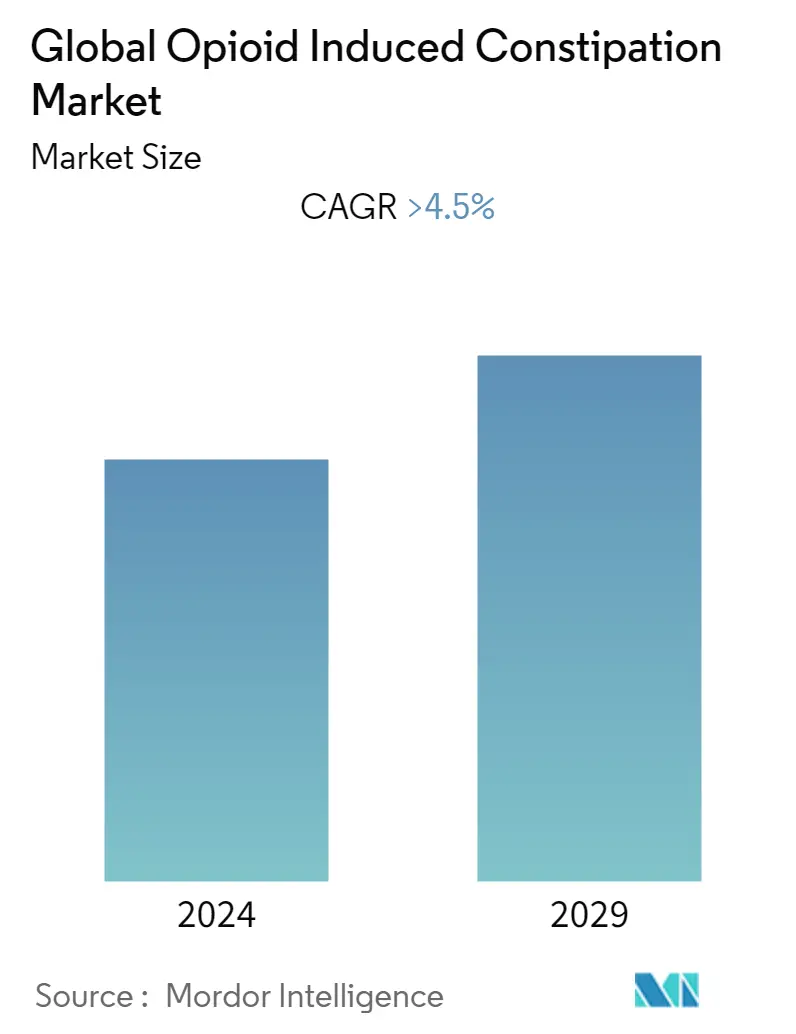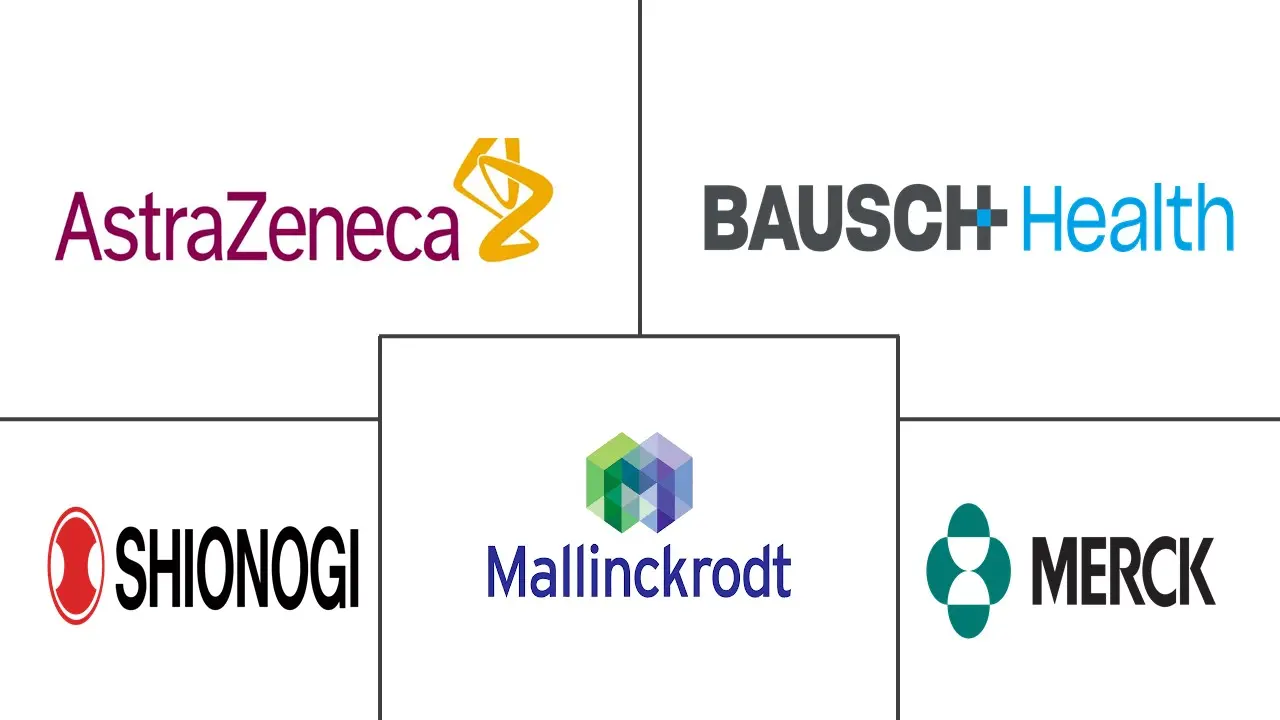Market Size of Global Opioid Induced Constipation Industry

| Study Period | 2019 - 2029 |
| Base Year For Estimation | 2023 |
| Forecast Data Period | 2024 - 2029 |
| CAGR | 4.50 % |
| Fastest Growing Market | Asia Pacific |
| Largest Market | North America |
Major Players
*Disclaimer: Major Players sorted in no particular order |
Opioid Induced Constipation (OIC) Market Analysis
Opioid-Induced Constipation (OIC) market studied was anticipated to grow with a CAGR of nearly 4.5% during the forecast period, 2022-2027.
Opioid use at high doses and for long periods can impair immune system function, complicating the course of COVID-19 disease. In various stages of COVID-19, potential suppression of parts of the immune response may be important in prevention, clinical support, and therapeutic use of medications. Additionally, as per the World Health Organization update of August 2021, During the COVID-19 pandemic, there are a substantial increase in drug overdose deaths reported in the USA, primarily driven by rapid increases in overdose deaths involving synthetic opioids Because of such instances, the federal government has taken initiatives to careful usage of opioids drugs and side effects associated with it, which can later impact the growth of the studied market.
The major factor attributing to the growth of the market is an increasing number of geriatric patients as these patients use opioid analgesics such as morphine, hydromorphone, codeine, etc. as a prescription for chronic non-cancer pain which has severe adverse effects on the digestive system resulting in huge demand for OIC drugs. For instance, according to the Center for Diseases Control and Prevention November 2021, the number of OIC prescriptions increased by 153,260,450 in 2019 and 142,816,781 in 2020. Thus, the rising volume of patient pool with opioid users demands efficient medication for OIC ailments which is likely to fuel the Opioid-Induced Constipation market over the forecast period.
The geriatric population is expected to have a significant impact on the market studied as people aged above 65 are more prone to chronic diseases. According to the World Health Organization Facts 2021, by 2030, 1 out of every 6 people on the planet will be 60 years old or older. The number of people aged 60 and up is expected to rise from 1 billion in 2020 to 1.4 billion by 2050. By 2050, the global population of people aged 60 and above will get double to reach 2.1 billion. Between 2020 and 2050, the number of people aged 80 and above is expected to triple, reaching 426 million. Thus, the increasing use of opioid analgesic prescriptions along with the growing geriatric population in developed nations boosted the market over the forecast period.
However, lack of awareness about OIC among the patients considering it as a syndrome resulting in a preference for general laxatives and ongoing research activities to develop next-generation analgesics to replace opioids are likely to hamper the market growth. In contrast, the rise in the global geriatric population preferring OIC drugs for efficient, rapid relief and awareness among the developed nations is expected to boost the growth of the market.
Opioid Induced Constipation (OIC) Industry Segmentation
Opioid analgesics are prescribed to patients with acute and chronic non-cancer pain. They reduce the secretion of digestive enzymes which results in opioid-induced constipation with several symptoms including bloating, distention, bulged abdomen, and painful defecation due to hard and dry stools. The Opioid-Induced Constipation Market is Segmented by Drug Class (Mu-opioid Receptor Antagonists, Chloride Channel-2 Activators, and Others), Prescription Type (Over The Counter, Prescription), End-User (Hospital Pharmacies, Retail Pharmacies, Online Pharmacies) and Geography (North America, Europe, Asia-Pacific, Middle East and Africa, and South America). The market report also covers the estimated market sizes and trends for 17 different countries across major regions, globally. The report offers the value (in USD million) for the above segments.
| By Drug Class | |
| Mu-opioid Receptor Antagonists | |
| Chloride Channel-2 Activators | |
| Others |
| By Prescription Type | |
| Over The Counter | |
| Prescription |
| By End-User | |
| Hospital Pharmacies | |
| Retail Pharmacies | |
| Online Pharmacies |
| Geography | ||||||||
| ||||||||
| ||||||||
| ||||||||
| ||||||||
|
Global Opioid Induced Constipation Market Size Summary
The Opioid-Induced Constipation (OIC) market is poised for growth, driven by the increasing prevalence of opioid use, particularly among the geriatric population who are often prescribed opioid analgesics for chronic pain management. This demographic shift is significant as older adults are more susceptible to chronic diseases, necessitating the use of opioids, which in turn leads to a higher demand for OIC treatments. The market is further influenced by the rising awareness and availability of Mu-opioid receptor antagonists, which are gaining traction due to their efficacy in treating OIC. These developments are supported by ongoing research and product launches, which are expected to enhance the therapeutic options available for managing opioid-induced constipation.
North America is anticipated to lead the OIC market, largely due to the high consumption of opioids and the prevalence of gastrointestinal disorders among the elderly in the region. The United States, in particular, is witnessing a surge in OIC prescriptions, bolstered by advanced healthcare infrastructure and expedited drug approval processes. The competitive landscape of the market is characterized by the presence of major pharmaceutical players who are actively engaging in strategic collaborations and product innovations to strengthen their market position. These efforts, coupled with the increasing availability of effective OIC treatments, are expected to drive market growth and expand the therapeutic options for patients suffering from opioid-induced constipation.
Global Opioid Induced Constipation Market Size - Table of Contents
-
1. MARKET DYNAMICS
-
1.1 Market Overview
-
1.2 Market Drivers
-
1.2.1 Rise in the Availability of Effective OIC Drugs Along with Growing Prevalence of Chronic Idiopathic Pains
-
1.2.2 Increasing Use of Opioid Analgesic Prescriptions Along with Growing Geriatric Population in Developed Nations
-
-
1.3 Market Restraints
-
1.3.1 Clinical Trials on Next Generation Analgesics as an Alternative to Opioid Analgesics
-
1.3.2 Lack of Awareness and Reluctance Among Patients due to Adverse Effects of OIC Drugs
-
-
1.4 Porter's Five Forces Analysis
-
1.4.1 Threat of New Entrants
-
1.4.2 Bargaining Power of Buyers/Consumers
-
1.4.3 Bargaining Power of Suppliers
-
1.4.4 Threat of Substitute Products
-
1.4.5 Intensity of Competitive Rivalry
-
-
-
2. MARKET SEGMENTATION (Market Size by Value - USD million)
-
2.1 By Drug Class
-
2.1.1 Mu-opioid Receptor Antagonists
-
2.1.2 Chloride Channel-2 Activators
-
2.1.3 Others
-
-
2.2 By Prescription Type
-
2.2.1 Over The Counter
-
2.2.2 Prescription
-
-
2.3 By End-User
-
2.3.1 Hospital Pharmacies
-
2.3.2 Retail Pharmacies
-
2.3.3 Online Pharmacies
-
-
2.4 Geography
-
2.4.1 North America
-
2.4.1.1 United states
-
2.4.1.2 Canada
-
2.4.1.3 Mexico
-
-
2.4.2 Europe
-
2.4.2.1 Germany
-
2.4.2.2 United Kingdom
-
2.4.2.3 France
-
2.4.2.4 Italy
-
2.4.2.5 Spain
-
2.4.2.6 Rest of Europe
-
-
2.4.3 Asia-Pacific
-
2.4.3.1 China
-
2.4.3.2 Japan
-
2.4.3.3 India
-
2.4.3.4 Australia
-
2.4.3.5 South Korea
-
2.4.3.6 Rest of Asia-Pacific
-
-
2.4.4 Middle East and Africa
-
2.4.4.1 GCC
-
2.4.4.2 South Africa
-
2.4.4.3 Rest of Middle East and Africa
-
-
2.4.5 South America
-
2.4.5.1 Brazil
-
2.4.5.2 Argentina
-
2.4.5.3 Rest of South America
-
-
-
Global Opioid Induced Constipation Market Size FAQs
What is the current Global Opioid Induced Constipation Market size?
The Global Opioid Induced Constipation Market is projected to register a CAGR of greater than 4.5% during the forecast period (2024-2029)
Who are the key players in Global Opioid Induced Constipation Market?
AstraZeneca plc, Merck & Co Inc, Shionogi & Co Ltd, Mallinckrodt Pharmaceuticals and Bausch Health ( Salix Pharmaceutical Inc.) are the major companies operating in the Global Opioid Induced Constipation Market.

